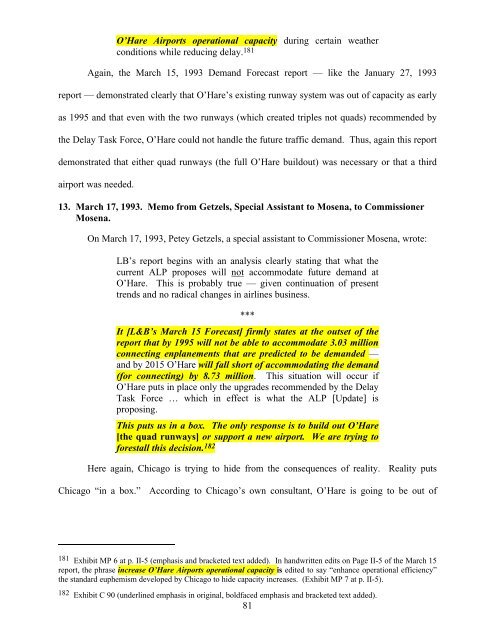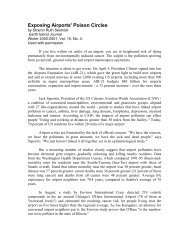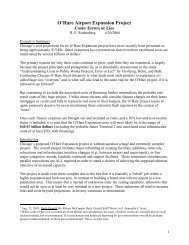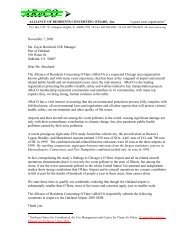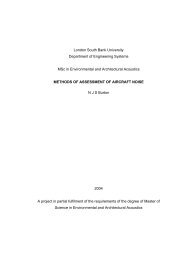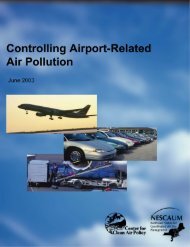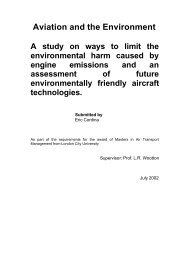evidentiary appendix in support of plaintiffs' partial motion for ...
evidentiary appendix in support of plaintiffs' partial motion for ...
evidentiary appendix in support of plaintiffs' partial motion for ...
You also want an ePaper? Increase the reach of your titles
YUMPU automatically turns print PDFs into web optimized ePapers that Google loves.
O’Hare Airports operational capacity dur<strong>in</strong>g certa<strong>in</strong> weather<br />
conditions while reduc<strong>in</strong>g delay. 181<br />
Aga<strong>in</strong>, the March 15, 1993 Demand Forecast report — like the January 27, 1993<br />
report — demonstrated clearly that O’Hare’s exist<strong>in</strong>g runway system was out <strong>of</strong> capacity as early<br />
as 1995 and that even with the two runways (which created triples not quads) recommended by<br />
the Delay Task Force, O’Hare could not handle the future traffic demand. Thus, aga<strong>in</strong> this report<br />
demonstrated that either quad runways (the full O’Hare buildout) was necessary or that a third<br />
airport was needed.<br />
13. March 17, 1993. Memo from Getzels, Special Assistant to Mosena, to Commissioner<br />
Mosena.<br />
On March 17, 1993, Petey Getzels, a special assistant to Commissioner Mosena, wrote:<br />
LB’s report beg<strong>in</strong>s with an analysis clearly stat<strong>in</strong>g that what the<br />
current ALP proposes will not accommodate future demand at<br />
O’Hare. This is probably true — given cont<strong>in</strong>uation <strong>of</strong> present<br />
trends and no radical changes <strong>in</strong> airl<strong>in</strong>es bus<strong>in</strong>ess.<br />
***<br />
It [L&B’s March 15 Forecast] firmly states at the outset <strong>of</strong> the<br />
report that by 1995 will not be able to accommodate 3.03 million<br />
connect<strong>in</strong>g enplanements that are predicted to be demanded —<br />
and by 2015 O’Hare will fall short <strong>of</strong> accommodat<strong>in</strong>g the demand<br />
(<strong>for</strong> connect<strong>in</strong>g) by 8.73 million. This situation will occur if<br />
O’Hare puts <strong>in</strong> place only the upgrades recommended by the Delay<br />
Task Force … which <strong>in</strong> effect is what the ALP [Update] is<br />
propos<strong>in</strong>g.<br />
This puts us <strong>in</strong> a box. The only response is to build out O’Hare<br />
[the quad runways] or <strong>support</strong> a new airport. We are try<strong>in</strong>g to<br />
<strong>for</strong>estall this decision. 182<br />
Here aga<strong>in</strong>, Chicago is try<strong>in</strong>g to hide from the consequences <strong>of</strong> reality. Reality puts<br />
Chicago “<strong>in</strong> a box.” Accord<strong>in</strong>g to Chicago’s own consultant, O’Hare is go<strong>in</strong>g to be out <strong>of</strong><br />
181 Exhibit MP 6 at p. II-5 (emphasis and bracketed text added). In handwritten edits on Page II-5 <strong>of</strong> the March 15<br />
report, the phrase <strong>in</strong>crease O’Hare Airports operational capacity is edited to say “enhance operational efficiency”<br />
the standard euphemism developed by Chicago to hide capacity <strong>in</strong>creases. (Exhibit MP 7 at p. II-5).<br />
182 Exhibit C 90 (underl<strong>in</strong>ed emphasis <strong>in</strong> orig<strong>in</strong>al, boldfaced emphasis and bracketed text added).<br />
81


